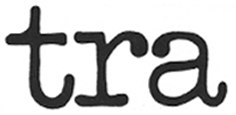The beginning of a new Canadian avant-garde and/or radical consciousness dates from about 1970. Although sporadic attempts were made by some groups and galleries in the sixties (such as the artists’ circle around Michael Snow, who left Toronto in the mid-sixties for a decade in New York). Throughout the sixties, neither a strong consciousness, nor a rethinking of the art structure were cultivated. 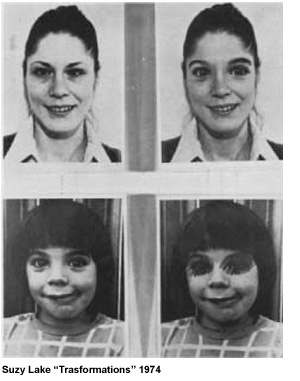 Only at the turn of the decade did the new socializing movements begin to take shape through the cafes, new theatre groups, collectives of political, feminist and most importantly the gay liberation movement. Parallel, though seldom connected to these collective movements, artists groups worked around the new art functions of conceptual and post-Warhol extractions. The influence from the States, both West Coast and New York, were primary ones. Internationally known artists (Emmett Williams, Dan Graham, Joan Jonas, Sol Lewitt and others) were invited to work directly with the students at the Nova Scotia College of Art and Design. The effect was a Canada-wide interest in Conceptual art and video. Influenced by the Halifax School in the same interest for video was the Guelph University School of Fine Art under the direction of Eric Cameron with the later collaboration of Noel Harding. In Toronto, the short and stormy administration of Roy Ascott at OCA during 1971-72 ended with a split between the student; and the more conservative faculty at the College. The brief academic experiment carried out by Ascott and the even briefer radical school Z that came out of that experiment formed a strong direction for the “arte povera” or new sculpture as evolved in the work of Colette Whiten and Heather MacDonald. At the dissolution of Z, an experimental wing was opened at the College (1973) which has built up one of the best equipped video and audio studios in the country. Also through those facilities, Michael Page, introduced holography as art and was followed in that medium by Al Razutis, Fringe Research and International Global Tools. The new media, especially video, catalyzed a new consciousness. Between 1971 and 1973, video as an alternative to conventional media, was used by practically the groups working in the artistic and political undergrounds. During the same period, marginal groups and centres (later classified as parallel) were originating and beginning to survive through a program of the Canada Council.That program reached a turning point in 1976 with the establishment of a network of alternative centres called CANPAC. The Canada Council program funds about twenty organizations, some devoted to specific disciplines and some not. The groups receiving support from the Canada Council program include the larger centres, such as Aspace and CEAC in Toronto, Vehicule in Montreal and smaller ones like Eye Leve in Halifax, SAW in Ottawa, Plug-in in Winnipeg, Parachute in Calgary and the Western Front in Vancouver. The program has emphasized the alternative role for exhibitions by new artists and the non-commercial nature of the work of those artists. The funding of alternative centres, though a minimal amount of the Canada Council budget, represents a tremendously high return in cultural development with an upgrading of the Canadian image at home and abroad with little economic risk.
Only at the turn of the decade did the new socializing movements begin to take shape through the cafes, new theatre groups, collectives of political, feminist and most importantly the gay liberation movement. Parallel, though seldom connected to these collective movements, artists groups worked around the new art functions of conceptual and post-Warhol extractions. The influence from the States, both West Coast and New York, were primary ones. Internationally known artists (Emmett Williams, Dan Graham, Joan Jonas, Sol Lewitt and others) were invited to work directly with the students at the Nova Scotia College of Art and Design. The effect was a Canada-wide interest in Conceptual art and video. Influenced by the Halifax School in the same interest for video was the Guelph University School of Fine Art under the direction of Eric Cameron with the later collaboration of Noel Harding. In Toronto, the short and stormy administration of Roy Ascott at OCA during 1971-72 ended with a split between the student; and the more conservative faculty at the College. The brief academic experiment carried out by Ascott and the even briefer radical school Z that came out of that experiment formed a strong direction for the “arte povera” or new sculpture as evolved in the work of Colette Whiten and Heather MacDonald. At the dissolution of Z, an experimental wing was opened at the College (1973) which has built up one of the best equipped video and audio studios in the country. Also through those facilities, Michael Page, introduced holography as art and was followed in that medium by Al Razutis, Fringe Research and International Global Tools. The new media, especially video, catalyzed a new consciousness. Between 1971 and 1973, video as an alternative to conventional media, was used by practically the groups working in the artistic and political undergrounds. During the same period, marginal groups and centres (later classified as parallel) were originating and beginning to survive through a program of the Canada Council.That program reached a turning point in 1976 with the establishment of a network of alternative centres called CANPAC. The Canada Council program funds about twenty organizations, some devoted to specific disciplines and some not. The groups receiving support from the Canada Council program include the larger centres, such as Aspace and CEAC in Toronto, Vehicule in Montreal and smaller ones like Eye Leve in Halifax, SAW in Ottawa, Plug-in in Winnipeg, Parachute in Calgary and the Western Front in Vancouver. The program has emphasized the alternative role for exhibitions by new artists and the non-commercial nature of the work of those artists. The funding of alternative centres, though a minimal amount of the Canada Council budget, represents a tremendously high return in cultural development with an upgrading of the Canadian image at home and abroad with little economic risk. 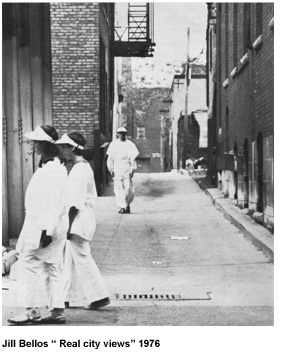 Through economic manipulations the Canada Council is stabilizing the direction of Canadian contemporary arts lt is simultaneously removing program support from the smaller and less “productive” centres and strengthening those which have proved themselves through opening of cultural avenues and establishing national identities. Typically, this process has reestablished competitiveness in these centres, so that no unity exists and little communication even in those areas of shared interest. New forms of theatre, music, literature, visual art tend to lack a united front but some groups share common directions. Neo-dada activity, now in decline, was shared by the West Coast artists, in particular those at the Western Front (Mr. Peanut, Or. Brute, Anna Banana, Opal L Nations) and Toronto artists (Ms Honey, Pascal, the General Idea). They all followed the European dadaists, the Fluxus and Warhol’s way of expression. The correspondence activity of the neo-dadaists (originated by the Vancouver Corresponge Dance School and the Image Bank) is being continued by Chuck Stake.
Image collage and video have found a mutual ground in camp theatre (the Hummer Sisters’ rock play, the General Idea’s Beauty Pageants, the Dishes “soft rock” group). Around these neo-dada groups, there is a persistent number of initiated, all coherently following the set of fetishes each group establishes, such as the palm tree symbol, gossip, fashion, Salvation Army chic. A small group particular to Toronto, has a strong interest in body works, behavior and the relationship between the body and its environment. These body artists started in street performances as the Shitbandit group (a loose association of radicals and artists). Bruce Eves (S&M and Taboo mode studies), Wendy Knox Leet, Ron Gillespie, Lilly Chiro, Marlene are representatives although Gillespie’s work is definitely the strongest as purist Body-Art performance work. The body Art performances in Toronto are more strongly influenced by the utopian social activity of Joseph Beuys and the mythology of Hermann Nitsch and Otto Muehi than the Body Art of New York (Acconci, Palestine). This area of performance is more European than any other Canadian art activity.
Through economic manipulations the Canada Council is stabilizing the direction of Canadian contemporary arts lt is simultaneously removing program support from the smaller and less “productive” centres and strengthening those which have proved themselves through opening of cultural avenues and establishing national identities. Typically, this process has reestablished competitiveness in these centres, so that no unity exists and little communication even in those areas of shared interest. New forms of theatre, music, literature, visual art tend to lack a united front but some groups share common directions. Neo-dada activity, now in decline, was shared by the West Coast artists, in particular those at the Western Front (Mr. Peanut, Or. Brute, Anna Banana, Opal L Nations) and Toronto artists (Ms Honey, Pascal, the General Idea). They all followed the European dadaists, the Fluxus and Warhol’s way of expression. The correspondence activity of the neo-dadaists (originated by the Vancouver Corresponge Dance School and the Image Bank) is being continued by Chuck Stake.
Image collage and video have found a mutual ground in camp theatre (the Hummer Sisters’ rock play, the General Idea’s Beauty Pageants, the Dishes “soft rock” group). Around these neo-dada groups, there is a persistent number of initiated, all coherently following the set of fetishes each group establishes, such as the palm tree symbol, gossip, fashion, Salvation Army chic. A small group particular to Toronto, has a strong interest in body works, behavior and the relationship between the body and its environment. These body artists started in street performances as the Shitbandit group (a loose association of radicals and artists). Bruce Eves (S&M and Taboo mode studies), Wendy Knox Leet, Ron Gillespie, Lilly Chiro, Marlene are representatives although Gillespie’s work is definitely the strongest as purist Body-Art performance work. The body Art performances in Toronto are more strongly influenced by the utopian social activity of Joseph Beuys and the mythology of Hermann Nitsch and Otto Muehi than the Body Art of New York (Acconci, Palestine). This area of performance is more European than any other Canadian art activity.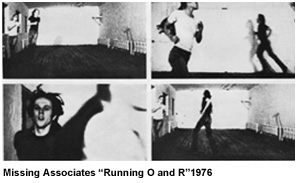 Within performance-art it stands opposite to the narrative story performance of Dawn Eagle, General Idea, Miss Honey or Suzy Lake. Suzy Lake with Bill Vazan, Andrew Dutkewych, Tom Dean, Serge Tousignant and Dennis Lukas formed Montreal’s collective alternative gallery Vehicule in 1973. Under their collective efforts emphasis has been placed on an alternative press and video under the direction of Andree Duchaine. In 1975, the Vehicule critic Chantal Pontbriand launched the magazine “Parachute”. Also in Montreal, Gilles Gheerbrandt runs the other important privately run gallery in Canada (the first being Carmen Lamanna). The arrival of Carmen Lamanna in Toronto was essential for the realization and growth of innovation within the artistic milieu. Lamanna was the one art dealer to encourage the first experiments in the new forms of land art, post minimalism and later some attempts in narrative art. A number of specialized alternative exhibition and performance areas have developed since 1974 in disciplines like new music and dance. The Music Gallery established in Toronto in 1975 is run by the CCMC Canadian Creative Music Collective consisting of Al Mattes, Larry Dubin, Michael Snow and others). After the films “ Rameau’s nephew” and “ Two sides to every story” Michael Snow has been consistently involved in jazz improvisation on piano and trumpet. The 15 Dance Lab directed by Lawrence and Miriam Adams is dedicated to new forms of dance. Improvisation, both in music and dance, is the main mode of expression of the newer artists. Few are the ones using structural approach like Lubomyr Melnyk (music), or the Missing Associates and John Faichney (dance). Even more marginal to these tendencies are the electronic and live executions by Ted Dawson, Diane Boadway and Ross McClarin. Such improvisational dancers as Gill Bellos and Victoria Tansey Sommer have been largely influenced by Hann Haiprin (on the West Coast) and by Simone Forti. Video Inn, working from Vancouver, has been accumulating since 1974 a considerable number of tapes through the Satellite Video Exchange. But the tendency of building archives, typical of Vancouver groups (image Bank, Satellite Video Exchange, Chicken Bank), is at a certain extent also a tendency we find evidence in Toronto.
Within performance-art it stands opposite to the narrative story performance of Dawn Eagle, General Idea, Miss Honey or Suzy Lake. Suzy Lake with Bill Vazan, Andrew Dutkewych, Tom Dean, Serge Tousignant and Dennis Lukas formed Montreal’s collective alternative gallery Vehicule in 1973. Under their collective efforts emphasis has been placed on an alternative press and video under the direction of Andree Duchaine. In 1975, the Vehicule critic Chantal Pontbriand launched the magazine “Parachute”. Also in Montreal, Gilles Gheerbrandt runs the other important privately run gallery in Canada (the first being Carmen Lamanna). The arrival of Carmen Lamanna in Toronto was essential for the realization and growth of innovation within the artistic milieu. Lamanna was the one art dealer to encourage the first experiments in the new forms of land art, post minimalism and later some attempts in narrative art. A number of specialized alternative exhibition and performance areas have developed since 1974 in disciplines like new music and dance. The Music Gallery established in Toronto in 1975 is run by the CCMC Canadian Creative Music Collective consisting of Al Mattes, Larry Dubin, Michael Snow and others). After the films “ Rameau’s nephew” and “ Two sides to every story” Michael Snow has been consistently involved in jazz improvisation on piano and trumpet. The 15 Dance Lab directed by Lawrence and Miriam Adams is dedicated to new forms of dance. Improvisation, both in music and dance, is the main mode of expression of the newer artists. Few are the ones using structural approach like Lubomyr Melnyk (music), or the Missing Associates and John Faichney (dance). Even more marginal to these tendencies are the electronic and live executions by Ted Dawson, Diane Boadway and Ross McClarin. Such improvisational dancers as Gill Bellos and Victoria Tansey Sommer have been largely influenced by Hann Haiprin (on the West Coast) and by Simone Forti. Video Inn, working from Vancouver, has been accumulating since 1974 a considerable number of tapes through the Satellite Video Exchange. But the tendency of building archives, typical of Vancouver groups (image Bank, Satellite Video Exchange, Chicken Bank), is at a certain extent also a tendency we find evidence in Toronto.
 Art Metropole, CEAC, WAVE (World Association Video Editions) are all part of a large international network of exchanges. Art Metropole, inheriting the information from “File” magazine, established a video and an artists publication distribution service. CEAC, through Wave, is the repository of tapes, publications, and films (in particular Super 8) received by the scouting from all over the world. Recently more international events have taken place. The recent Wave video events was an occasion to view tapes from Japan, East and West Europe, the US and from Canada. Parallel to the parallel, the KAA, later known as the CEAC in Toronto located the neglected marginal areas of art and society. In particular, the KAA introduced the paradigms of Language-Art. Early investigations were Peter Melnick’s plays, Beth Learn’s analytical approach and the Manifestos of the Blastbloom Associates. In the fall of 1975, the KAA organized together with Richard Kostelanetz, the largest language art show ever presented.
This mammoth work included most of the structural language experiences of the last decade, both from Canada and the US. Over two hundred and fifty artists participated with books, manuscripts and tapes. A large program of live events held within the exhibition included performances Vito Acconci, Yvonne Rainer, Jackson MacLow, The Four Horsemen, Agnes Denes and Peter Melnick. Artists participating to the exhibition included: John Cage, Steve Reich, Lawrence Weiner, Emmett Williams, John Giorno, Sol Lewitt, Michael Snow, Hollis Frampton, Carie Andre. Canadians affected by the avalanche of Language Art were Peter Melnick, David Tipe, Joan Chisholm and Beth Learn, who while working within the KAA coined the term “contextualism”, The definition although in accurate, was prophetic in the sense of anticipating the large new wave of Contextual Art and its recent ramifications. A 1974 article in Toronto “Only Paper Today” by Blastbloom referred to Contextual Art as having quantitative, not qualitative definition. Contextual Art has bridged the wide gap existing between Canadian development under New York influences and the long neglected European reality. East Europeans, Polish in particular, seem to share similar experiences with Canadian artists in deriving an influence born elsewhere, but developed outside and beyond Conceptual Art modes. The work of Robakowski, Swidzinski, Wasko and the Lodz Filmform share the premises and the concerns with the CEAC structural artists: Peter Dudar, Lily Eng, David Fujino, Brian Kipping, Doug Duart. The media used include, film video, performance and language art but the references and the sensitivity ere the same: intentional, structural, materialist. lf there is a common ground within the CEAC school, it is the dialectical materialism of the work elaborated within the Centre for Experimental Art Et Communication group.
Art Metropole, CEAC, WAVE (World Association Video Editions) are all part of a large international network of exchanges. Art Metropole, inheriting the information from “File” magazine, established a video and an artists publication distribution service. CEAC, through Wave, is the repository of tapes, publications, and films (in particular Super 8) received by the scouting from all over the world. Recently more international events have taken place. The recent Wave video events was an occasion to view tapes from Japan, East and West Europe, the US and from Canada. Parallel to the parallel, the KAA, later known as the CEAC in Toronto located the neglected marginal areas of art and society. In particular, the KAA introduced the paradigms of Language-Art. Early investigations were Peter Melnick’s plays, Beth Learn’s analytical approach and the Manifestos of the Blastbloom Associates. In the fall of 1975, the KAA organized together with Richard Kostelanetz, the largest language art show ever presented.
This mammoth work included most of the structural language experiences of the last decade, both from Canada and the US. Over two hundred and fifty artists participated with books, manuscripts and tapes. A large program of live events held within the exhibition included performances Vito Acconci, Yvonne Rainer, Jackson MacLow, The Four Horsemen, Agnes Denes and Peter Melnick. Artists participating to the exhibition included: John Cage, Steve Reich, Lawrence Weiner, Emmett Williams, John Giorno, Sol Lewitt, Michael Snow, Hollis Frampton, Carie Andre. Canadians affected by the avalanche of Language Art were Peter Melnick, David Tipe, Joan Chisholm and Beth Learn, who while working within the KAA coined the term “contextualism”, The definition although in accurate, was prophetic in the sense of anticipating the large new wave of Contextual Art and its recent ramifications. A 1974 article in Toronto “Only Paper Today” by Blastbloom referred to Contextual Art as having quantitative, not qualitative definition. Contextual Art has bridged the wide gap existing between Canadian development under New York influences and the long neglected European reality. East Europeans, Polish in particular, seem to share similar experiences with Canadian artists in deriving an influence born elsewhere, but developed outside and beyond Conceptual Art modes. The work of Robakowski, Swidzinski, Wasko and the Lodz Filmform share the premises and the concerns with the CEAC structural artists: Peter Dudar, Lily Eng, David Fujino, Brian Kipping, Doug Duart. The media used include, film video, performance and language art but the references and the sensitivity ere the same: intentional, structural, materialist. lf there is a common ground within the CEAC school, it is the dialectical materialism of the work elaborated within the Centre for Experimental Art Et Communication group.
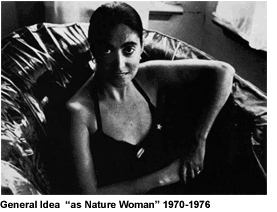 Bruce Eves (il quale studia modelli di taboo e di sadomasochismo), Wendy Knox Leet, Ron Gillespie (senza dubbio il più purista ed estremo in questa forma d’arte), Lilly Chiro, Marlene sono i più rappresentativi del movimento. Le azioni di body art di Toronto sono state influenzate notevolmente da quelle di Joseph Beuys e dalla mitologia di Hermann Nitsch e Otto Muhel più che dai body artist di New York, Acconci e Palestine. Questa area di performance è molto più europea rispetto a qualsiasi altra espressione artistica in Canada. Entro l’ambito della performance art ci si oppone all’arte narrativa di Dawn Eagle, General Idea, Miss Honey e Suzy Lake. Suzy Lake con Bili Vazan, Andrew Dutkewych, Tom Dean, Serge Tousignant e Dennis Lukas hanno formato nel 1973 il centro alternativo d’arte Vehicule. Sotto la direzione collettiva di questo centro hanno visto la luce le attività video (dirette da Andree Duchaine) e alcune pubblicazioni alternative. Nel 1975, dal gruppo Vehicule nasce la rivista “Parachute” diretta da Chantal Pontbriand. Ancora a Montreal, Gille Gheerbrandt apre un’altra galleria d’arte privata molto importante. L’arrivo di Carmen Lamanna a Toronto, comunque, rimane essenziale per il riconoscimento e la crescita di un rinnovamento entro il milieu artistico. Lamanna è il primo mercante d’arte a incoraggiare i recenti esperimenti nelle nuove forme dei land art, di post minimalismo e in seguito di narrative art.
Bruce Eves (il quale studia modelli di taboo e di sadomasochismo), Wendy Knox Leet, Ron Gillespie (senza dubbio il più purista ed estremo in questa forma d’arte), Lilly Chiro, Marlene sono i più rappresentativi del movimento. Le azioni di body art di Toronto sono state influenzate notevolmente da quelle di Joseph Beuys e dalla mitologia di Hermann Nitsch e Otto Muhel più che dai body artist di New York, Acconci e Palestine. Questa area di performance è molto più europea rispetto a qualsiasi altra espressione artistica in Canada. Entro l’ambito della performance art ci si oppone all’arte narrativa di Dawn Eagle, General Idea, Miss Honey e Suzy Lake. Suzy Lake con Bili Vazan, Andrew Dutkewych, Tom Dean, Serge Tousignant e Dennis Lukas hanno formato nel 1973 il centro alternativo d’arte Vehicule. Sotto la direzione collettiva di questo centro hanno visto la luce le attività video (dirette da Andree Duchaine) e alcune pubblicazioni alternative. Nel 1975, dal gruppo Vehicule nasce la rivista “Parachute” diretta da Chantal Pontbriand. Ancora a Montreal, Gille Gheerbrandt apre un’altra galleria d’arte privata molto importante. L’arrivo di Carmen Lamanna a Toronto, comunque, rimane essenziale per il riconoscimento e la crescita di un rinnovamento entro il milieu artistico. Lamanna è il primo mercante d’arte a incoraggiare i recenti esperimenti nelle nuove forme dei land art, di post minimalismo e in seguito di narrative art.
← top page part two →
